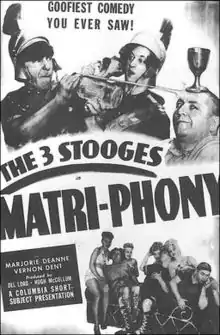Matri-Phony
Matri-Phony is a 1942 short subject directed by Harry Edwards starring American slapstick comedy team The Three Stooges (Moe Howard, Larry Fine and Curly Howard). It is the 63rd entry in the series released by Columbia Pictures starring the comedians, who released 190 shorts for the studio between 1934 and 1959.
| Matri-Phony | |
|---|---|
 | |
| Directed by | Harry Edwards |
| Produced by | Del Lord Hugh McCollum |
| Written by | Monte Collins Elwood Ullman |
| Starring | Moe Howard Larry Fine Curly Howard Vernon Dent Monte Collins Marjorie Deanne Cy Schindell Eddy Chandler Max Wagner |
| Cinematography | George Meehan |
| Edited by | Paul Borofsky |
| Distributed by | Columbia Pictures |
Release date |
|
Running time | 17:08 |
| Country | United States |
| Language | English |
Plot
The Stooges live in "Ancient Erysipelas," (parody of Ancient Rome) where they run Ye Olde Pottery shop. The powerful Emperor Octopus Grabus (Vernon Dent) is in search for a new wife again, with his sights set on redheads. Lovely Diana (Marjorie Deanne), who has kindled Grabus' interest, hides out in the Stooges' shop. A palace guard catches onto the scheme and all are brought to Grabus which are condemned to be fed to the lions at the Colosseum. The boys help Diana escape, while Moe and Larry convince Curly to dress up as Octopus's prospective bride. These two then destroy the glasses of the nearly-blind Grabus, who cannot see past his nose. The Stooges make a rapid escape by jumping out a palace windows, but end getting caught, upside-down, on the spears of palace guards.
Cast
- Curly Howard as Curleycue (as Curly)
- Larry Fine as Larrycus (as Larry)
- Moe Howard as Mohicus (as Moe)
- Marjorie Deanne as Diana
- Vernon Dent as Emperor Octopus Grabus
Production notes
Matri-Phony was the first short filmed in 1942, shot over a period of three weeks between March 5 and March 25, 1942."[1] It is the first Stooge film to employ the accordion-based, driving version of "Three Blind Mice" over the opening credits. This faster theme would be used until the end of 1944.[1] The film title is a pun on the word "matrimony.[1]
Matri-Phony had a difficult gestation. The three-week shooting schedule was unusual for a Columbia short film, as most were completed over four consecutive days. It is not known how many days it took to film, with six being an estimate.[2] There were material script changes, reshoots and deleted footage, with most of the blame aimed at director Harry Edwards who had developed a reputation at Columbia Pictures as the studio's worst director.[2] His poor directing skills are apparent throughout, with bad staging, awkward jump cuts and several unfocused shots. In the closing scene when the Stooges are hanging upside down from the guards' spears, Edwards inexplicably directed the guards to walk straight into a wall.[3] His voice can also be heard loudly directing Larry Fine: "Larry, grab the.....". Larry was the only one who was not holding onto his guard's trousers: after receiving his direction, Larry quickly grabbed the pants. This type of exchange would normally be muted during post-production.[4] After his next directoral effort with the Stooges (Three Little Twirps), the trio requested to never work with him again.[1]
Curly Howard also began to exhibit subtle hints of his slow physical decline. DVD Talk critic Stuart Galbraith IV noted that it is "demonstrated in a scene where he tries to eat a live crab (with snapping claws), a variation of the oyster-in-the-soup gag from the previous year (from Dutiful But Dumb). It's reasonably funny, but Curly's timing is just a tad off and the two scenes make quite a contrast."[3]
Quotes
Curly: "Oh, food!" (beholds the spread before him) "Vitamins A B C D E F GEE, I like food!"
References
- Solomon, Jon (2002). The Complete Three Stooges: The Official Filmography and Three Stooges Companion. Glendale, California: Comedy III Productions, Inc. p. 211. ISBN 0-9711868-0-4.
- Matri-Phony at threestooges.net
- Galbraith IV, Stuart (July 7, 2012). "The Three Stooges: The Ultimate Collection". DVD Talk. Retrieved September 5, 2013.
- Okuda, Ted; Watz, Edward (1986). The Columbia Comedy Shorts. McFarland & Company, Inc., Publishers. p. 214. ISBN 0-89950-181-8.